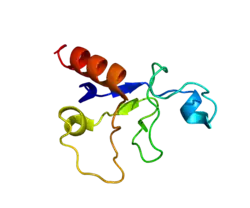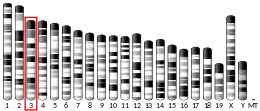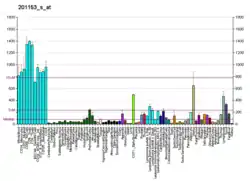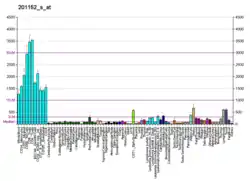MBNL1
Muscleblind Like Splicing Regulator 1 (MBNL1) is an RNA splicing protein that in humans is encoded by the MBNL1 gene.[5][6][7] It has a well characterized role in Myotonic dystrophy where impaired splicing disrupts muscle development and function.[8] In addition to regulating mRNA maturation of hundreds of genes MBNL1 (along with its paralogs MBNL2 & MBNL3) autoregulate alternative splicing of the MBNL1 pre-mRNA transcript.[9] The founding member of the human MBNL family of proteins was the Drosophila Muscleblind protein (PMID 9334280).
Human MBNL1 is an alternative splicing regulator that harbors dual function as both a repressor and activator for terminal muscle differentiation.[10] The repressive function of Human MBNL1 by sequestering at normal splice sites has been shown to lead to RNA-splicing defects that lead to muscular diseases.[11]
Human MBNL1 is a 370 amino acid protein[12] composed of four Zinc Finger protein domains of the CCCH type linked in tandem.[10] The MBNL1 protein specifically binds to double stranded CUG RNA expansions.[13] The Zinc Finger domains play a role in both protein:protein contacts as well as RNA:protein contacts when bound to an oligonucleotide.[10]
References
- GRCh38: Ensembl release 89: ENSG00000152601 - Ensembl, May 2017
- GRCm38: Ensembl release 89: ENSMUSG00000027763 - Ensembl, May 2017
- "Human PubMed Reference:". National Center for Biotechnology Information, U.S. National Library of Medicine.
- "Mouse PubMed Reference:". National Center for Biotechnology Information, U.S. National Library of Medicine.
- Ishikawa K, Nagase T, Nakajima D, Seki N, Ohira M, Miyajima N, et al. (October 1997). "Prediction of the coding sequences of unidentified human genes. VIII. 78 new cDNA clones from brain which code for large proteins in vitro". DNA Research. 4 (5): 307–13. doi:10.1093/dnares/4.5.307. PMID 9455477.
- Miller JW, Urbinati CR, Teng-Umnuay P, Stenberg MG, Byrne BJ, Thornton CA, Swanson MS (September 2000). "Recruitment of human muscleblind proteins to (CUG)(n) expansions associated with myotonic dystrophy". The EMBO Journal. 19 (17): 4439–48. doi:10.1093/emboj/19.17.4439. PMC 302046. PMID 10970838.
- "Entrez Gene: MBNL1 muscleblind-like (Drosophila)".
- Ho TH, Charlet-B N, Poulos MG, Singh G, Swanson MS, Cooper TA (August 2004). "Muscleblind proteins regulate alternative splicing". The EMBO Journal. 23 (15): 3103–12. doi:10.1038/sj.emboj.7600300. PMC 514918. PMID 15257297.
- Konieczny P, Stepniak-Konieczna E, Sobczak K (January 2018). "MBNL expression in autoregulatory feedback loops". RNA Biology. 15 (1): 1–8. doi:10.1080/15476286.2017.1384119. PMC 5786016. PMID 28949831.
- Teplova M, Patel DJ (December 2008). "Structural insights into RNA recognition by the alternative-splicing regulator muscleblind-like MBNL1". Nature Structural & Molecular Biology. 15 (12): 1343–51. doi:10.1038/nsmb.1519. PMC 4689322. PMID 19043415.
- Yadava RS, Kim YK, Mandal M, Mahadevan K, Gladman JT, Yu Q, Mahadevan MS (July 2019). "MBNL1 overexpression is not sufficient to rescue the phenotypes in a mouse model of RNA toxicity". Human Molecular Genetics. 28 (14): 2330–2338. doi:10.1093/hmg/ddz065. PMC 6606845. PMID 30997488.
- Tchaicheeyan O (2007). Biophysical characterization of the 117 amino acids long N-terminal segment of D-Raf (Isoform A) (Thesis). Iowa State University. doi:10.31274/rtd-180813-16211.
- "MBNL1 muscleblind like splicing regulator 1 [Homo sapiens (human)] - Gene - NCBI". www.ncbi.nlm.nih.gov. Retrieved 2019-05-05.
Further reading
- Bonaldo MF, Lennon G, Soares MB (September 1996). "Normalization and subtraction: two approaches to facilitate gene discovery". Genome Research. 6 (9): 791–806. doi:10.1101/gr.6.9.791. PMID 8889548.
- Fardaei M, Larkin K, Brook JD, Hamshere MG (July 2001). "In vivo co-localisation of MBNL protein with DMPK expanded-repeat transcripts". Nucleic Acids Research. 29 (13): 2766–71. doi:10.1093/nar/29.13.2766. PMC 55763. PMID 11433021.
- Mankodi A, Urbinati CR, Yuan QP, Moxley RT, Sansone V, Krym M, et al. (September 2001). "Muscleblind localizes to nuclear foci of aberrant RNA in myotonic dystrophy types 1 and 2" (PDF). Human Molecular Genetics. 10 (19): 2165–70. doi:10.1093/hmg/10.19.2165. PMID 11590133.
- Fardaei M, Rogers MT, Thorpe HM, Larkin K, Hamshere MG, Harper PS, Brook JD (April 2002). "Three proteins, MBNL, MBLL and MBXL, co-localize in vivo with nuclear foci of expanded-repeat transcripts in DM1 and DM2 cells". Human Molecular Genetics. 11 (7): 805–14. doi:10.1093/hmg/11.7.805. PMID 11929853.
- Kino Y, Mori D, Oma Y, Takeshita Y, Sasagawa N, Ishiura S (March 2004). "Muscleblind protein, MBNL1/EXP, binds specifically to CHHG repeats". Human Molecular Genetics. 13 (5): 495–507. CiteSeerX 10.1.1.598.7921. doi:10.1093/hmg/ddh056. PMID 14722159.
- Dansithong W, Paul S, Comai L, Reddy S (February 2005). "MBNL1 is the primary determinant of focus formation and aberrant insulin receptor splicing in DM1". The Journal of Biological Chemistry. 280 (7): 5773–80. doi:10.1074/jbc.M410781200. PMID 15546872.
- Ho TH, Savkur RS, Poulos MG, Mancini MA, Swanson MS, Cooper TA (July 2005). "Colocalization of muscleblind with RNA foci is separable from mis-regulation of alternative splicing in myotonic dystrophy". Journal of Cell Science. 118 (Pt 13): 2923–33. doi:10.1242/jcs.02404. PMID 15961406.
- Adereth Y, Dammai V, Kose N, Li R, Hsu T (December 2005). "RNA-dependent integrin alpha3 protein localization regulated by the Muscleblind-like protein MLP1". Nature Cell Biology. 7 (12): 1240–7. doi:10.1038/ncb1335. PMC 2365307. PMID 16273094.
- Monferrer L, Artero R (2006). "An interspecific functional complementation test in Drosophila for introductory genetics laboratory courses". The Journal of Heredity. 97 (1): 67–73. doi:10.1093/jhered/esj003. PMID 16394256.
- Cardani R, Mancinelli E, Rotondo G, Sansone V, Meola G (2007). "Muscleblind-like protein 1 nuclear sequestration is a molecular pathology marker of DM1 and DM2". European Journal of Histochemistry. 50 (3): 177–82. PMID 16920640.
- Paul S, Dansithong W, Kim D, Rossi J, Webster NJ, Comai L, Reddy S (September 2006). "Interaction of muscleblind, CUG-BP1 and hnRNP H proteins in DM1-associated aberrant IR splicing". The EMBO Journal. 25 (18): 4271–83. CiteSeerX 10.1.1.673.6397. doi:10.1038/sj.emboj.7601296. PMC 1570429. PMID 16946708.
- Smith KP, Byron M, Johnson C, Xing Y, Lawrence JB (September 2007). "Defining early steps in mRNA transport: mutant mRNA in myotonic dystrophy type I is blocked at entry into SC-35 domains". The Journal of Cell Biology. 178 (6): 951–64. doi:10.1083/jcb.200706048. PMC 2064620. PMID 17846170.







